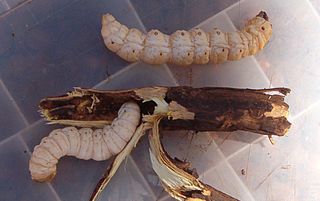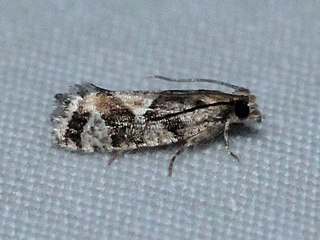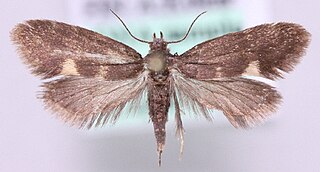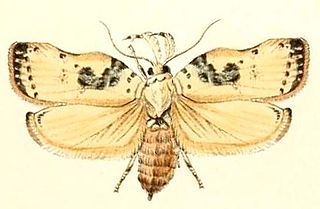
Lepidoptera is an order of insects that includes butterflies and moths. About 180,000 species of the Lepidoptera are described, in 126 families and 46 superfamilies, 10 per cent of the total described species of living organisms. It is one of the most widespread and widely recognizable insect orders in the world. The Lepidoptera show many variations of the basic body structure that have evolved to gain advantages in lifestyle and distribution. Recent estimates suggest the order may have more species than earlier thought, and is among the four most speciose orders, along with the Hymenoptera, Diptera, and Coleoptera.

The Tortricidae are a family of moths, commonly known as tortrix moths or leafroller moths, in the order Lepidoptera. This large family has over 10,350 species described, and is the sole member of the superfamily Tortricoidea, although the genus Heliocosma is sometimes placed within this superfamily. Many of these are economically important pests. Olethreutidae is a junior synonym. The typical resting posture is with the wings folded back, producing a rather rounded profile.

The witchetty grub is a term used in Australia for the large, white, wood-eating larvae of several moths. In particular, it applies to the larvae of the cossid moth Endoxyla leucomochla, which feeds on the roots of the witchetty bush that is widespread throughout the Northern Territory and also typically found in parts of Western Australia and South Australia, although it is also found elsewhere throughout Australia.

The Limacodidae or Eucleidae are a family of moths in the superfamily Zygaenoidea or the Cossoidea; the placement is in dispute. They are often called slug moths because their caterpillars bear a distinct resemblance to slugs. They are also called cup moths because of the shape of their cocoons.

Dioryctria sylvestrella, the new pine knot-horn or maritime pine borer, is a moth of the family Pyralidae. It is found in Europe, parts of Asia and North Africa. The adult is a small mottled brown and white insect with a wingspan of 28 to 35 mm. The moth flies in a single generation from June to October and is a pest of maritime pine and several other species of pine, on which the caterpillars feed.

Gillmeria ochrodactyla is a moth of the family Pterophoridae found in Asia and Europe. It was first described by the Austrian entomologists, Michael Denis & Ignaz Schiffermüller in 1775.

Zeiraphera canadensis, the spruce bud moth, is a moth of the family Tortricidae. It is a small brown moth mainly found in North America, specifically New Brunswick, Quebec, and the north-eastern United States. The adult moth flutters quickly, and stays low among trees during the day and higher above tree cover after sunset. The spruce bud moth relies primarily on the white spruce tree as a host plant. Both male and female spruce bud moths mate multiply, however males have the ability to secrete accessory gland proteins that prevent female re-mating. The moth is univoltine, meaning only one generation hatches per year, and its eggs overwinter from July to May. The species Z. ratzeburgiana is very similar to Z. canadensis and can only be distinguished by the presence of an anal comb in Z. canadensis.
Ectoedemia albibimaculella is a moth of the family Nepticulidae. It is found from Fennoscandia to Italy.

Psorosticha zizyphi is a moth of the family Depressariidae.

Penicillaria jocosatrix, the mango shoot borer, is a moth of the family Noctuidae first described by Achille Guenée in 1852. It is found from southeast Asia to the Pacific. Records include Borneo, Guam, Hawaii, India, Sri Lanka, Thailand and in Australia, Western Australia, the Northern Territory and Queensland.

Oidaematophorus lithodactyla, also known as the dusky plume, is a moth of the family Pterophoridae found from Europe to Asia Minor and Japan. It was first described by German lepidopterist, Georg Friedrich Treitschke in 1833.

Blastodacna atra, the apple pith moth is a moth of the family Elachistidae. It is known from most of Europe and it has been introduced to North America.

Dioryctria zimmermani, the Zimmerman pine moth, is a moth of the family Pyralidae. It is found from southern Canada and the north-eastern and Great Lakes areas of the United States. There is a disjunct population in eastern Nebraska.

Rhyacionia bushnelli, the western pine tip moth, is a moth of the family Tortricidae. It is found in the United States, including Alabama, Nebraska, North Dakota and Montana.

The currant shoot borer moth is a species of moth of the family Prodoxidae. It is found in most of central, northern and eastern Europe. It is also found in North America.

Depressaria ultimella is a moth of the family Depressariidae. It is found in most of Europe, except Spain, Norway, Finland, Lithuania, Switzerland, Italy and most of the Balkan Peninsula.
Phymatopus californicus, the lupine ghost moth, is a species of moth belonging to the family Hepialidae. It was described by Jean Baptiste Boisduval in 1868 and is known from the US state of California.

Lampronia morosa is a moth of the family Prodoxidae. It is found in most of Europe, except Ireland, Latvia, Lithuania, Portugal and part of the Balkan Peninsula. It is also present in the Caucasus and Asia Minor.

Tonica effractella is a moth in the family Depressariidae. It was described by Snellen in 1879. It is found in Australia, where it has been recorded from the Northern Territory, Queensland, New South Wales and Western Australia.
Scrobipalpa ocellatella, the beet moth, is a moth in the family Gelechiidae. It was described by Boyd in 1858. It is found on Madeira and the Canary Islands, and in North Africa, most of Europe, the Middle East, Iran, from the southern part of European Russia to the Caucasus, as well as in Ukraine, Moldova, Georgia and Turkmenistan.
















